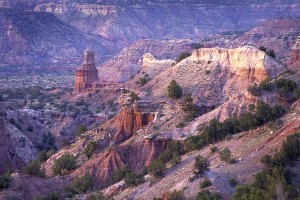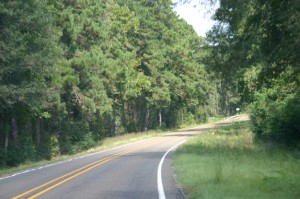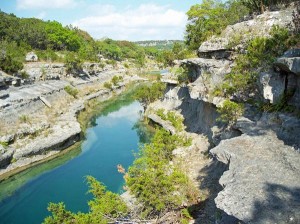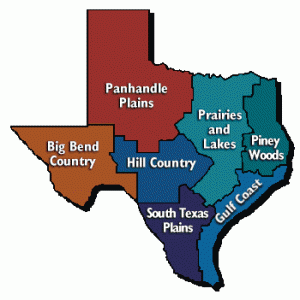Most peoples’ impression of what the Texas landscape looks like comes from California.
Think about it. Most people get their ideas of Texas from television and the movies, from Westerns set in Texas and filmed in California. So most people tend to think of Texas as, well, dirt. Desert.
And there is desert in Texas. Just not the whole of the state. It’s a big place, remember.
The movie Happy, Texas was filmed in California. I have not actually driven down the main street in Happy–yes, there is a town in Texas named Happy–but I have driven within a mile of it. Happy is in the Texas Panhandle, about 15 miles from the city of Canyon, which is about 30 miles south of Amarillo.
 |
| Palo Duro Canyon, Texas Panhandle |
In the movie, there are orange groves and picturesque mountains surrounding the California setting. One of the times I drove by Happy, there was a blizzard howling and I was driving very slowly to get through the blowing snowfall without running off the road. Orange trees would freeze to death.
The terrain around Happy is flat as a pancake, except for the big hole in the ground nearby that is the Palo Duro Canyon, and the main row crops there are cotton, peanuts and grain sorghum. Lots and lots of each. But according to the movies…
So. According to the little map I put up above, there are seven main regions in Texas. In this blog, I’m going to try to give a bit of an overview–orient the Big Six cities in the regions where they belong, hopefully without going off on too many tangents.
 |
| East Texas road, through the Piney Woods |
The East Texas Piney Woods also includes the Big Thicket. This is an area where the growth under the trees is so dense, you pretty much need a machete to get through it. Not exactly desert. You do not cross the Sabine River between Louisiana and Texas and automatically run into desert. The terrain in East Texas is pretty much the same as you get in Louisiana. Swamps in the south near the coast, pine tree forest north of that. As you drive from Houston to Dallas, you will gradually leave the Piney Woods behind for the “Prairies and Lakes” region.
Houston is big enough, it runs from the Coastal Plain into the Piney Woods. (And yes, it is always called “Piney” which rhymes with whiny. Deal.) The Memorial section of Houston is definitely in the Piney Woods. South Houston is definitely coastal.
Dallas and Fort Worth are both in the “Prairies and Lakes” region. I am using quotation marks because there is only one (maybe) natural lake in the state of Texas. Every single lake, except maybe Caddo Lake in East Texas, is man-made from a dammed-up river, and I’m not absolutely positive about Caddo. The traditional name for this region is Cross-timber Prairie or the Crosstimbers, because it’s prairie–rolling hills that are mostly meadow–but those meadows are crossed with big stands of timber. Trees. In bands that probably correspond with underground water. These trees are not pines, for the most part. They are primarily oaks with hackberry, elm, juniper and other trees mixed in. Except for the Lost Pines region in Bastrop County, just outside of Austin, pine trees do not readily grow anywhere in Texas outside of the Piney Woods. So you really can’t have a “Pine Ridge” anywhere in West Texas. Just sayin’. I’ll try to remember to say a little more about Lost Pines when I’m talking more about the flora of Texas.
 |
| Hill Country River–non-drought year |
Austin is at the edge of the Hill Country. The Hill Country (which is different from Hill County, just north of Waco and smack in the middle of the blackland prairie) was formed millennia ago from the Balcones Escarpment and the Edwards Plateau. But don’t ask me how. I just know that the rocks are mostly limestone, the trees are almost exclusively live oak, mesquite and juniper with some cedar elm thrown in, and there are hills. Really beautiful hills. It’s dry, but there are a lot of springs. You get some beautiful views from the tops of some of those hills.
San Antonio has traditionally been considered the gateway to South Texas. It’s just past the edge of the Hill Country–it’s closer to Fredericksburg, Kerrville and Boerne (pronounced Burney) (three of the main Hill Country towns) than Austin is–at the top of the South Texas Plains. The only trees I remember seeing in that area are mesquites. Nothing tall. Probably yaupon holly, which will grow about as tall as a mesquite. Maybe some juniper. And cottonwoods along the rivers. “Alamo” is Spanish for “cottonwood.”
El Paso is part of the Big Bend Country. The Big Bend is where you get actual desert, real mountains and some more canyons. The Palo Duro, in the Panhandle, is the biggest canyon in the state. In fact, it’s the second biggest in the country. But there are some nice canyons along the Rio Grande. Mesquites still grow, but they look more like shrubs in this part of the country. Giant yucca are the bigger “trees.”
There are no huge cities in either the Panhandle Plains or the Piney Woods. Well, Houston is sort of in the Piney Woods. It’s just at the very southern edge of it… Lubbock, Amarillo, Abilene, and Wichita Falls are the biggest cities in the Panhandle Plains region, all over 100,000 population, and San Angelo comes close. In the Piney Woods, Tyler and Longview are each just under 100,000, and they’re close enough to each other that they share their metropolitan area. But all the other cities are smaller. Plenty of small towns for authors to write about small-town Texas. It’s just that–for writers, East Texas isn’t very “Texas-y.” Too many trees, not enough cows.
Stay tuned. More tangents ahead.





